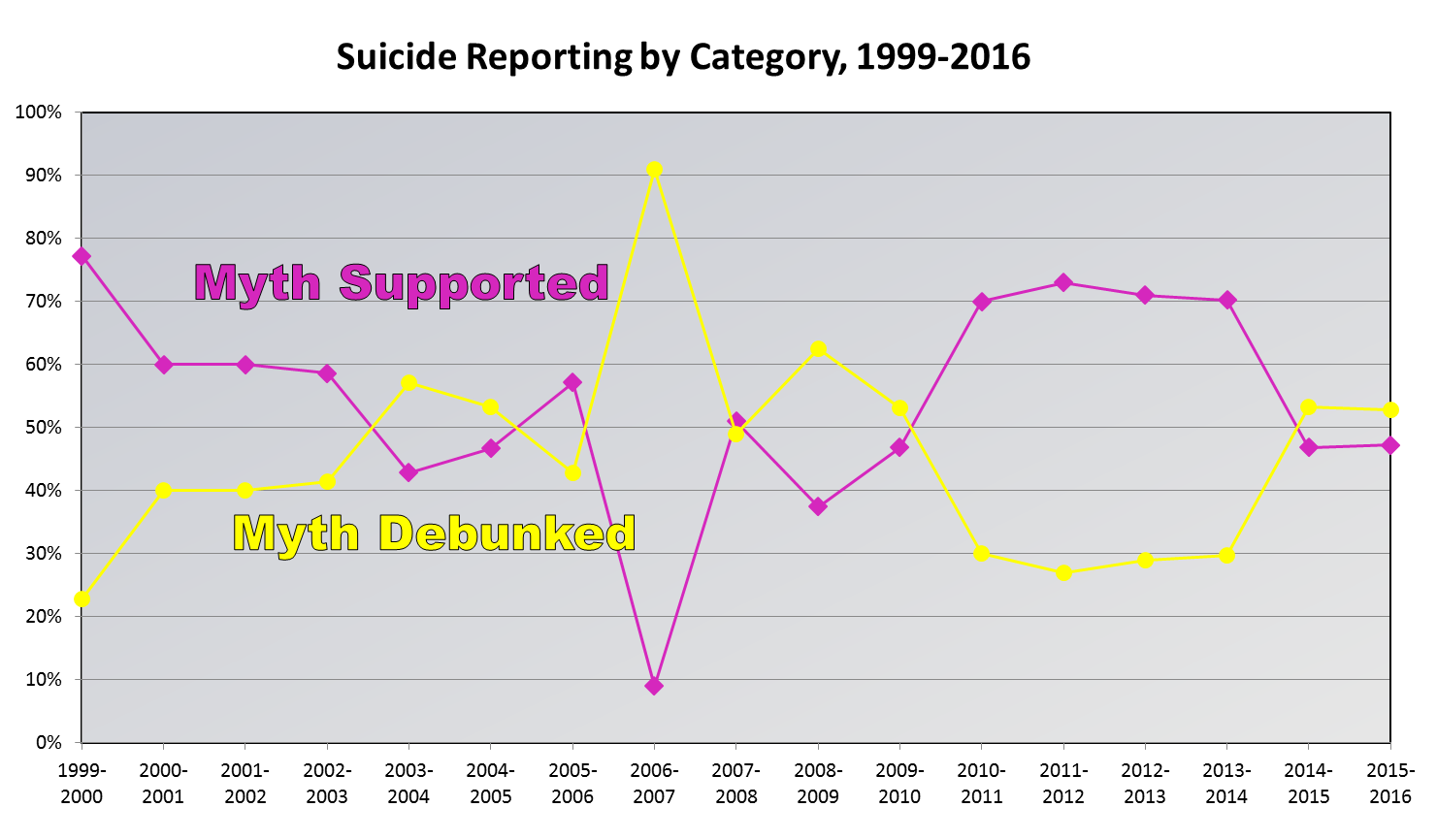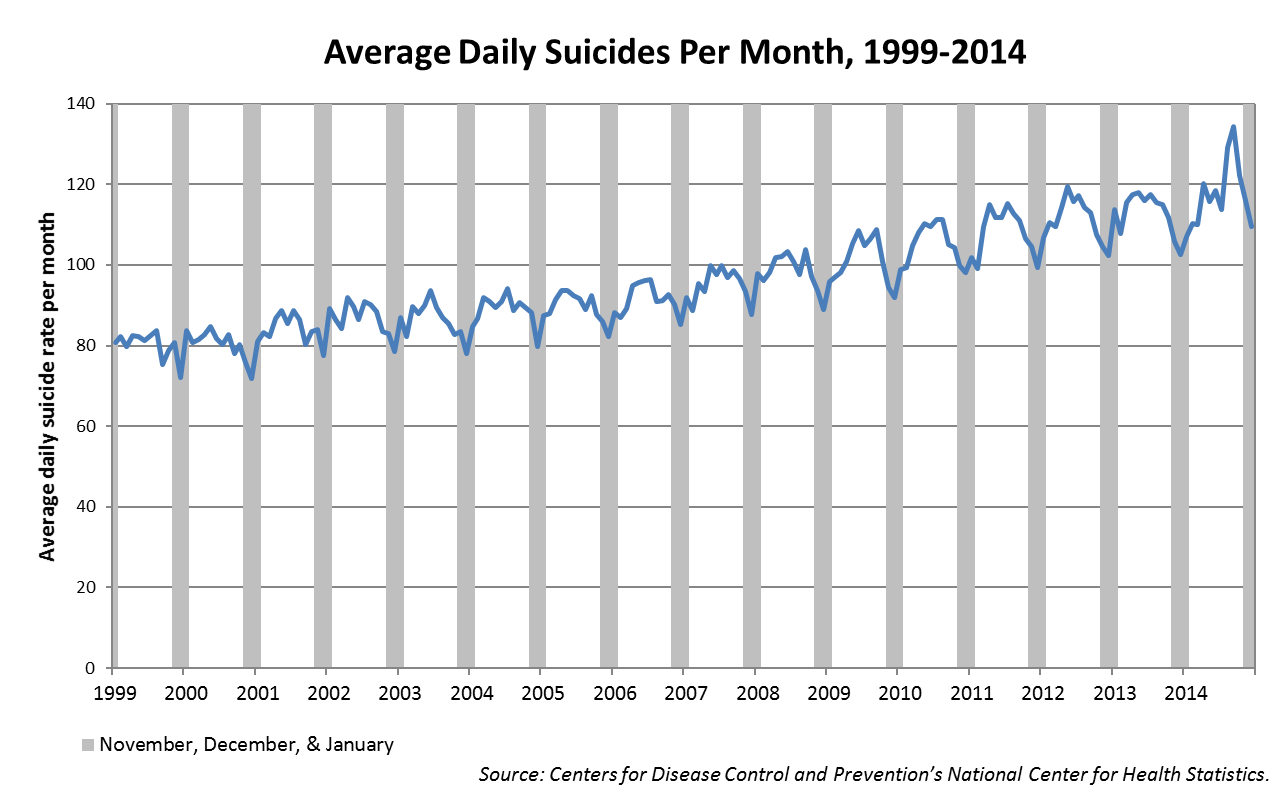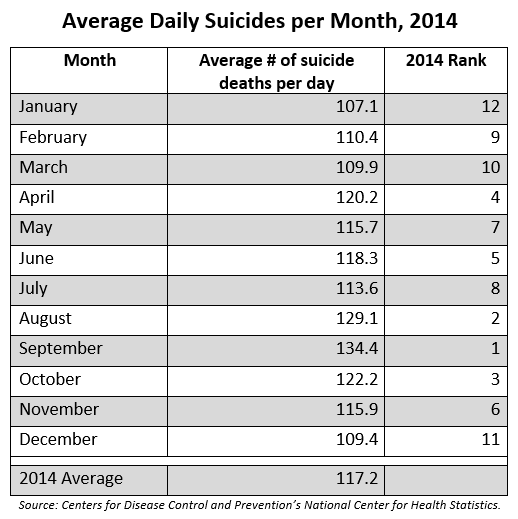Nearly half of the news stories over last year’s holiday season that linked the holidays and suicide perpetuated the myth that there is an increase in suicides from Thanksgiving through January, according to an analysis by the Annenberg Public Policy Center.

The annual analysis found that 47 percent of the stories in the Nexis database over the 2015-16 holiday season upheld the false connection while 53 percent debunked it, the same as the prior year (see Figure 1).
“People are still confused about this,” said Dan Romer, research director of the Annenberg Public Policy Center (APPC) of the University of Pennsylvania. “You find almost as many stories supporting the myth as debunking it.”
In fact, the holiday season usually has the lowest suicide rates of the year (see Figure 2). Data from the Centers for Disease Control and Prevention (CDC) show that in 2014 (the latest year of available data), December and January had the fewest average suicide deaths per day. The rate in November was slightly below the average for the year. The highest daily rates usually occur between April and August – and in 2014, were in August and September (see Table 1 below).
APPC has tracked news coverage on this issue for 17 years, starting in 1999-2000, and only in two of those years have more than 60 percent of stories debunked the myth. About half of the years have seen a roughly even split in the number of news stories that have upheld or debunked the myth that suicides increase around the holidays. In other years, the myth was supported by a majority of the stories.
“This is a very difficult myth to erase,” Romer said.

The current analysis, from mid-November 2015 through January 2016, found that 19 stories debunked the holiday-suicide myth and 17 supported it. A religion story from the Cleveland (Tennessee) Daily Banner that supported the myth said: “We are in the midst of celebrating the commemoration of the birth of Christ. It should be a joyous occasion. But statistics tell us that more people suffer depression and more people are prone to suicide during the holidays than at any other time.”
Some stories don’t support the myth – or debunk it
Some stories which were excluded from the analysis didn’t endorse the myth but didn’t debunk it either. One example is a January arts feature in the San Francisco Chronicle about “the world’s most depressed musician,” Morrissey, which quotes a theater director as saying, “Blue Monday is considered the most depressing day of the year. I think it has the most suicides.”
Another example, from the Reno Gazette-Journal in Nevada, tries to have it both ways: “Although it is purportedly a myth that suicide rates increase during the holiday season, this can nonetheless be a difficult time for a great many of us.” Saying that the myth has purportedly been debunked does little to dispel doubts.
“News stories mentioning suicide around the holidays may seek to be helpful, but they can misinform people and fail to provide advice on how to cope with stress during the holidays,” Romer said. “Even a casual reference or an unverified assertion in a quotation can end up supporting the myth and potentially discourage those vulnerable to suicide from seeking the care they need.”
Recommendations for media coverage of suicide (see www.reportingonsuicide.org) note that reporters should consult reliable sources on suicide rates, such as those produced by the CDC, and provide information about resources that can be helpful to those in need.
Other resources include the Suicide Prevention Resource Center, www.sprc.org, and the CDC: http://www.cdc.gov/ViolencePrevention/suicide/holiday.html. The U.S. Surgeon General’s strategy for the prevention of suicide encourages more accurate reporting on the causes: http://www.samhsa.gov/prevention/suicide.aspx. The U. S. National Suicide Prevention Lifeline can be reached at 800-273-TALK (8255).
Methodology
News and feature stories linking suicide with the holidays were identified through the Nexis database, with “suicide” and “Thanksgiving/Christmas/New Years” or “holidays” as search terms from November 15, 2015 through January 31, 2016. Researchers evaluated whether the stories supported the link, debunked it, or showed a coincidental link. Only domestic suicides were counted; overseas suicide bombings, for example, were excluded. Thanks go to Ilana Weitz, who collected and supervised the coding of the stories, and to Anna Rose Bedrosian and Daniel Bersani-Molina for assistance in coding. Thanks also go to Alex Crosby of the CDC for assistance in obtaining monthly rates of suicide.
To download this release, click here.

News coverage of APPC’s holiday-suicide myth analysis during the 2016-2017 holiday season included:
- 10 Misconceptions about Holidays (Mental Floss, January 1, 2017)
- Is Christmas Deadly? Cold Weather Not Linked To High Cardiac Arrest Rates, Study Says (International Business Times, December 23, 2016)
- Suicides actually go down during the holidays (Vox, December 20, 2016)
- The Truth About Suicides During the Holidays (ATTN:, December 18, 2016)
- Christmas depression and suicide: Myth or reality? [Hungarian] (Life.hu, December 15, 2016)
- Reminder: Suicides Don’t Actually Increase Around the Holidays (The Huffington Post, December 13, 2016)
- County health officials stress suicide ‘messaging’ (Sonoma Index-Tribune, December 8, 2016)
- Suicide and the myth of the holidays (Minnesota Public Radio, December 7, 2016)
- Why Do People Go Home for the Holidays? (Psych Central, December 7, 2016)
- The Holiday Syndrome: Who Exactly Came Up With the Idea of Those Christmas Blues? (Psychiatric Times, December 1, 2016)
- 3 Holiday Depression Myths: Which is fact and which is fiction? (Psychology Today, November 30, 2016)
- Are there more suicides during the holiday season? (The Dallas Morning News, November 29, 2016)
- Podcast: Do Suicides Increase During the Holidays? (Psych Central,


